|
The Crown was, arguably, Bishop's Stortford's most famous inn. It was certainly the largest, although that was not always the case. The original Crown, thought to have been built in the mid 16th century, was probably no more than a tavern serving the small community of Hockerill and putting-up the odd traveller. It was the creation of the Hockerill bypass in 1670, and increased traffic, that elevated it to inn status. Its ultimate size was seemingly achieved by a combination of buying-up other properties in the immediate vicinity and erecting new buildings, all of which were then inter-linked to form an extensive property with ample accommodation for travellers.
The oldest part of the inn was at the north-west corner; a timber-frame house with projecting upper storey and attic rooms. The original structure had three gables facing Hockerill Street but, as the photograph (c.1897) above clearly shows, the gable at its eastern end was later removed and a shop window inserted on the ground floor.
The larger timber-frame and plastered building that adjoins it, with projecting upper storey and attic rooms, was probably erected in the early 18th century. It had two large rooms downstairs, each of which were panelled and painted, and several good sized bedrooms on the first floor. Clearly visible beneath one bedroom is the northern entrance to the inn's yard, used by mail and stagecoaches travelling from the north en route to London. Above this a large wrought-iron bracket supported the Crown sign. This entrance is still evident today as a narrow, partly cobble-stoned roadway that leads to the rear of the present buildings erected after the inn was demolished. The former inn yard is now part of a car park.
An extension added to the rear of this building in the late 18th century comprised of a large room with a circular end and French casement windows that opened into the inn yard. It is said to have been especially built to accommodate the Prince Regent (later George IV) and his brother the Duke of York who regularly stopped here on their way to and from Newmarket. No doubt it was also used by other noble visitors when the prince wasn't in residence.
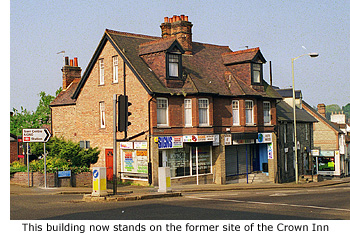 When the Crown finally closed, this particular building was altered for use and became, for a few years, the Exton Sayer Middle Class school. It subsequently became a private residence (the doorway seen in the middle replacing an oval shaped window) then later a private school.
When the Crown finally closed, this particular building was altered for use and became, for a few years, the Exton Sayer Middle Class school. It subsequently became a private residence (the doorway seen in the middle replacing an oval shaped window) then later a private school.
Brick buildings on the western side of the inn yard contained coach and chaise houses with stables, above which were granaries and stores. Behind these was a large garden area, last owned by a florist named Mr Watkins. His business was replaced in the early 1900s by the cottages that now form Crown Terrace. The southern end of the yard was enclosed by yet more stables and granaries, and an entrance that allowed access to mail traffic and stagecoaches coming from the direction of London. Both the south and north entrance was fitted with large oak gates studded with nails.
A timber-frame building at the Crown's southern-most end in London Road was adjoined by brick buildings used as further bedroom accommodation and offices, and during the reign of William IV (1830–1837), alterations were made to the south entrance. At the same time, on the south wall of the kiln house of the malting there, a large crown was formed in cement with the letters W.R. on each side and the figures IV above. Beneath was the name of the then landlord, Robert Percival.
Apart from the 'Royal' suite (previously mentioned) the Crown had numerous rooms for socialising. The cuisine was said to be excellent, and capacious wine cellars were always well stocked to cater for royal patronage and important meetings held at the inn. After Waytemore Castle was demolished in the 16th century the Bishop’s Court was transferred to the Crown, as were the Manorial Courts (Courts Leet) in the early 19th century. The trustees of the Essex and Herts Highway Trust held their first meeting at the inn on the 14 May 1744.
Its many famous guests over the years reads like a page from an historical ‘Who’s Who directory’. During a tour of England in the late 1600s, Cosmo III, Grand Duke of Tuscany stayed at the Crown and said he ‘slept well in Stortford’; Charles II, usually en route to Newmarket, stayed several times with his mistress Nell Gwynne; and in 1710 Daniel Defoe said he found it ‘exceedingly good’. John Wesley, founder of the Methodist Church, was not so complimentary. He stayed here overnight once and commented it was the dearest house he was ever in, but wished it well. In 1835, a coach carrying princess Victoria (later Queen Victoria) and her mother, the Duchess of Kent, changed horses at the Crown; and Robin Winstanley, brother of Henry Winstanley the architect and builder of the first Eddystone lighthouse, while ‘perambulating’ in 1667 from Littlebury to London, lodged for one night. He described his visit to Bishop's Stortford thus:
In a good plight my way I next address
Unto a place called Hockrell, and there took
In at the Crown, with honest Mr Cook;
Now here I did not entertainment lack,
With French-wine, Rhenish and Good Spanish sack;
And being dinner-time I filled my gullet
Begun with powdered beef, ended with pullet.
And after dinner we to drinking fixt,
With taking of tobacco intermixt,
Minding that town my journey's end should be
For that same night, I was resolved to see
The rareities of the same, which to disclose
A little while I'll turn my verse to prose.
He then gives a little account of the town, mentioning its fair and market, and continues his observations..
'This town is also accommodated with three Taverns, viz, the Crown, the Reindeer, and the George, at either of which, bringing the merry chink, you may have the merry drink. How many Ale houses is there, I had not time to number, only I saw the signs of some horned beasts, and the Bull, the Ram etc, but what the people are that dwell therein I know not, but guess you may have good liquor there for your money. As for the Cage and stocks there, let those who have been in them give you a description of them. And now after this serious view of the town, I returned to my quarters where I had dined, and took up my lodging there that night.'
In 1792 the Crown Inn is mentioned in the 'Universal British Directory'. Under Bishop's Stortford it reads:
The chief inn is the Crown, in Hockerill, which being on the Newmarket and Cambridge road has acquired the first consequence for the accommodation of noblemen and gentlemen.
Some years earlier, one such patron left his mark on a window pane in a ground floor room, by scratching the following with a diamond:
Charming Kitty Ede of St Paul's Churchyard
She has no faults or I no fault can spy,
She is all goodness or all blindness I.
Beneath the rhyme the author inscribed his name and address, as well as the date 'June 20th 1732', but only the date and the word 'Norfolk' was legible because the rest had been scratched out. The suggestion is that the writer's opinion of Kitty Ede may have changed, and on a subsequent visit to the inn he tried to erase his identy.
As would be expected of this time, patrons were regularly ‘entertained’ by Ladies of the Night. Charles James Fox MP was here on 6 April 1772, and is said to have found such ‘good company’ that he spent the night carousing. The following morning, having had no sleep, he went directly to the House of Commons to move his bill repealing the Marriage Act of 1753, defeating the Prime Minister, Lord North, by one vote.
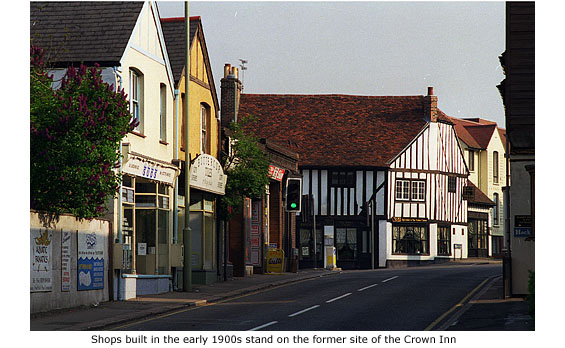
In 1773 the Crown gained some notoriety by the publication of a poem entitled 'Rape of Pomona an elegiac epistle from the waiter at Hockrel' [sic]. The book's preface refers to 'Mr Wilson's Inn at Hockrel' and states that the author of the poem is said to be a Cambridge student who has disguised himself as a waiter hired at Hockrel [sic].
Although built in the mid 16th century the earliest record of the inn occurs in 1601 when it was owned by Francis Abell, who paid 8d rent. He became a churchwarden in 1606 and his son, Francis Abell, junior, ran the White Horse Inn at North Street in 1619. Who followed Abell isn't recorded but in 1677 reference is made to Luke Cook. He appears to have been the owner and landlord until his death in 1692, leaving the property to his widow Susan Cook. When she died a few years later it went to her daughter, Mabel, who had married William Helmes, innholder. He seems to have occupied the Crown while it was owned by his wife, but when she died in 1708 the inn was puchased by Matthew Game. William Helmes then went to the Cock in the Fishmarket.
Matthew Game held the Crown until his death, which may have occurred prior to 1718 because in that year his widow paid the rent. The previous year the Crown had become the town's post office. Whether or not Mrs Game ran the Crown at that time is uncertain but the property remained in the family's ownership, and in 1725 Thomas Moore became the tenant. He and Thomas Adderley married the daughters of Matthew Game, and when Moore left the inn he was succeeded by his then brother-in-law, Thomas Adderley. Moore retired to Linton in 1756.
As landlord and postmaster, Adderley made his fortune at the Crown (a fact substantiated by entries in the Manorial Court Rolls) and then retired to the town. He later acted as a magistrate for the county, and on 21 July 1759 was sworn on the Commission of His Majesty's Justices and Commisioners of Sewers for the River Stort. He also served as churchwarden from 1761 to 1764 and was one of the trustees of the Stortford Charities.
In 1761, under the act for making the river Stort navigable, Adderley was appointed one of the commissioners. It was his duty to mediate between the undertakers of the work and those who owned or occupied land needed to make the project a reality. The navigation initially failed through lack of finance, but when George Jackson completed the task a few years later, he acknowledged the fact that Adderley had conceived the idea of making the Stort navigable (See Guide 11). Although Thomas Adderley wasn't born in Stortford, he served the town well throughout his life, which ended on 1 April 1774. His memorial in St Michael's church reads: 'He lived to see the good effects of those services with respect to the public'.
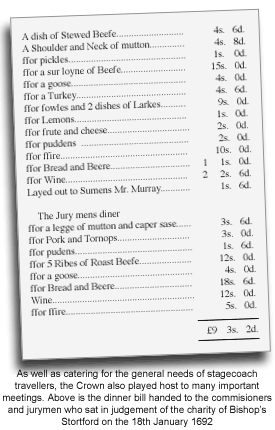 After Adderley's death the Crown passed to his sister, Mrs Hawes, and later to her son, Francis Hawes, who sold it to Roger Bolton. But who it was who actually succeeded Adderley is confusing. In 1773 the inn is said to have been Mr Wilson's, but if the inscription on Roger Bolton's memorial in the church is correct, which states he was landlord for 52 years, then he must have taken over the inn in 1764. Bolton, who was twice overseer of the parish, died in 1816, aged 92, and was buried in St Michael's churchyard. His epitaph there describes him as 'an honest man'. After Adderley's death the Crown passed to his sister, Mrs Hawes, and later to her son, Francis Hawes, who sold it to Roger Bolton. But who it was who actually succeeded Adderley is confusing. In 1773 the inn is said to have been Mr Wilson's, but if the inscription on Roger Bolton's memorial in the church is correct, which states he was landlord for 52 years, then he must have taken over the inn in 1764. Bolton, who was twice overseer of the parish, died in 1816, aged 92, and was buried in St Michael's churchyard. His epitaph there describes him as 'an honest man'.
The next owner was Richard Percival, a relative of Bolton by marriage, who held the inn until his death in 1823. He was apparently followed by his son Robert Percival, but on 22 August 1823 we find the Crown is up for sale with Messrs Sworders, estate agents and auctioneers. They describe the property thus: 'The Crown Inn', Hockerill, in a 'populous and opulent neighbourhood', (posting house); 25 bedrooms, 9 parlours and sitting rooms, detached tap; stabling for 80 horses.
Whether or not Robert Percival actually sold the inn after his father's death is unclear, but in 1828 the landlord is James Goodwin, while in 1829 Robert Percival is described as post and coach master. It was in Goodwin's time that the Stortford Lodge of Freemasons was formed and held its meetings at the Crown. When Goodwin moved to the George at North Street in 1834, so too did the freemasons. Percival appears to have taken over the Crown at that date and is listed as landlord in the 1839 Pigot's directory.
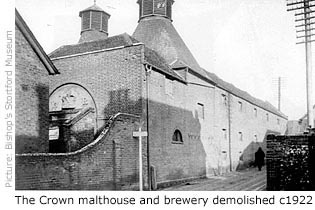 It's not apparent when Robert Percival ceased to be landlord of the Crown, though it must be assumed it was around 1842 when the railway arrived. Having been a posting house since the end of the 17th century, mail and stagecoach services to and from London then became redundant, making Percival the last landlord to operate the Crown as a large posting inn. He subsequently married Henry Gilbey’s widow and became the local registrar.
It's not apparent when Robert Percival ceased to be landlord of the Crown, though it must be assumed it was around 1842 when the railway arrived. Having been a posting house since the end of the 17th century, mail and stagecoach services to and from London then became redundant, making Percival the last landlord to operate the Crown as a large posting inn. He subsequently married Henry Gilbey’s widow and became the local registrar.
The 'detached tap' mentioned in Sworders 1823 sales description of the Crown, refers to the 'Crown Tap' – licenced premised that was sublet in the early 1800s in a part of the inn on the east side next to London Road. The tenant in 1828 was George Rider. Born c.1779, he had six daughters and two sons by his wife, Sarah, between 1802 and 1815. His oldest son, Henry, died in 1837, aged 29, and George died in 1844, aged 65. (Both are buried in St Michael's churchyard, their gravestones still visible.) His other son, George junior, born at Hertford in 1810, married Ann Bird (also born in Hertford) at St Michael's church in 1832. Between that time and 1853 they had 13 children.
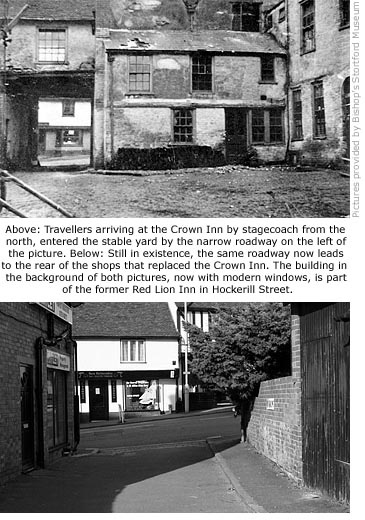 Coaches still operated beyond Stortford after the railway came, but when the line was extended to Newport and Cambridge in 1843, trade at the Crown declined dramatically. It was then, or shortly after, that George Rider jnr took over the inn. It may not have been the best business decision he ever made, but he and his large family appear in the 1851 census as living at the Crown. He is also listed as landlord in trade directories from 1850–1862. How long George remained landlord after 1862 is unknown, but by 1871 he and his wife Ann were living in London Road, Hockerill, and his occupation given as Ostler (invalid).
Coaches still operated beyond Stortford after the railway came, but when the line was extended to Newport and Cambridge in 1843, trade at the Crown declined dramatically. It was then, or shortly after, that George Rider jnr took over the inn. It may not have been the best business decision he ever made, but he and his large family appear in the 1851 census as living at the Crown. He is also listed as landlord in trade directories from 1850–1862. How long George remained landlord after 1862 is unknown, but by 1871 he and his wife Ann were living in London Road, Hockerill, and his occupation given as Ostler (invalid).
The following record of George Rider's death appeared in the Herts & Essex Observer 2nd March 1889. It gives a further insight into his early life.
'The death occurred on Friday last [22 Feb], of George Rider of Hockerill, who in the old coaching time acted as a post boy, and at the time the good old custom was abolished was the youngest coaching man while his father was the oldest. He was the last of the local stage coach men who used to travel from London to Cambridge, the headquarters at Hockerill being the old Crown. Of late years he had lived a very retired life and died at the age of 78. His funeral took place on Wednesday last [27 Feb] at Hockerill churchyard'.
In 1872 the Crown Inn closed for good. The stables and granaries next to London Road were sold and altered into a malting, and the northern and eastern parts of the premises converted into tenements. Stables and granaries that remained on the west and south sides of the inn yard were let as stores for corn merchants. The Crown Tap next to the Hockerill Street entrance retained a drinks licence, but this was ended a few years later when a Mr E.S. Davey bought the Crown site. The property then changed hands several times until, finally, it was sold to a builder who demolished it in 1898 to make way for Crown Terrace and the buildings that now stand here – all built in the early 20th century. The only part of the inn to survive for some time after was the malting in London Road that then stood between Hockerill Boys School and a property owned by a Mr R. Piper. But when this was sold 24 August 1922 and demolished that same year, removing every last trace of the Crown, it inspired former town historian J.L. Glasscock to write a newspaper article describing the inn. He ended it with these words:
The late Mr Henry Gilbey often told me the story of the coach poprietors who held a meeting to consider the comining of the railway. After a big dinner and a little discussion they went home very happy and said there was no fear of the railway coming so far, as it could not be expected that passengers would walk to the station to meet trains, when coaches picked them up at the cross roads.
But the railway came, and was destined to conquer the road. The coach and chaise with its post boys disappeared; travellers no longer changed horses at the Crown; there was no one to call for its wines, and this good old inn, in common with many others on the road, rapidly declined.
Such then was the end of the old Crown Inn at Hockerill, which although altered and adapted for other purposes might still have been preserved for many years to remind Stortford folk of the old coaching and posting days. But occurrences of this kind frequently pave the way for future improvements. It was so in this case for had it not been for the demolition of the Crown buildings we might not have had the much needed improvements in the width of the London road, which is now in progress.
*Much of this text has been drawn from J.L. Glasscock's newspaper article. Thanks also to Alison Offer for additional information regarding George Rider. MORE PICTURES
|


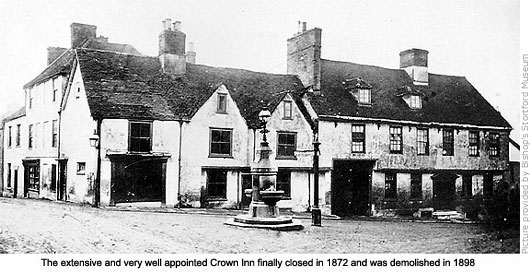

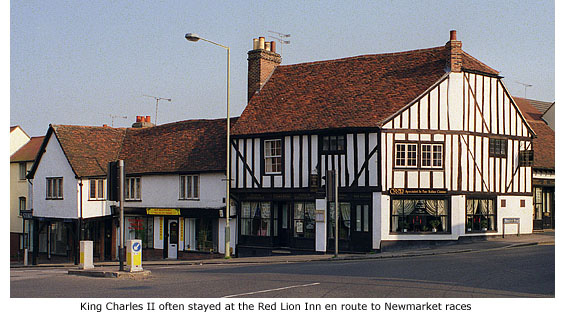
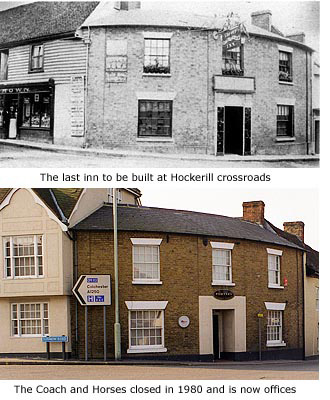 First mentioned in 1771, this was the last inn to be built at the crossroads and the only one constructed of brick. A victualer named Richard Thompson later bought the inn, becoming postmaster in 1784 for an annual salary of £85. 17s. 4d. This comprised a salary of £18 and allowances of £2, plus £65. 17s. 4d. for riding work. However, with the introduction of the Royal Mail coach service in 1795 he no longer had to carry out riding duties and his income was drastically reduced to a salary of just £18 per annum.
First mentioned in 1771, this was the last inn to be built at the crossroads and the only one constructed of brick. A victualer named Richard Thompson later bought the inn, becoming postmaster in 1784 for an annual salary of £85. 17s. 4d. This comprised a salary of £18 and allowances of £2, plus £65. 17s. 4d. for riding work. However, with the introduction of the Royal Mail coach service in 1795 he no longer had to carry out riding duties and his income was drastically reduced to a salary of just £18 per annum. When the Crown finally closed, this particular building was altered for use and became, for a few years, the Exton Sayer Middle Class school. It subsequently became a private residence (the doorway seen in the middle replacing an oval shaped window) then later a private school.
When the Crown finally closed, this particular building was altered for use and became, for a few years, the Exton Sayer Middle Class school. It subsequently became a private residence (the doorway seen in the middle replacing an oval shaped window) then later a private school. After Adderley's death the Crown passed to his sister, Mrs Hawes, and later to her son, Francis Hawes, who sold it to Roger Bolton. But who it was who actually succeeded Adderley is confusing. In 1773 the inn is said to have been Mr Wilson's, but if the inscription on Roger Bolton's memorial in the church is correct, which states he was landlord for 52 years, then he must have taken over the inn in 1764. Bolton, who was twice overseer of the parish, died in 1816, aged 92, and was buried in St Michael's churchyard. His epitaph there describes him as 'an honest man'.
After Adderley's death the Crown passed to his sister, Mrs Hawes, and later to her son, Francis Hawes, who sold it to Roger Bolton. But who it was who actually succeeded Adderley is confusing. In 1773 the inn is said to have been Mr Wilson's, but if the inscription on Roger Bolton's memorial in the church is correct, which states he was landlord for 52 years, then he must have taken over the inn in 1764. Bolton, who was twice overseer of the parish, died in 1816, aged 92, and was buried in St Michael's churchyard. His epitaph there describes him as 'an honest man'. It's not apparent when Robert Percival ceased to be landlord of the Crown, though it must be assumed it was around 1842 when the railway arrived. Having been a posting house since the end of the 17th century, mail and stagecoach services to and from London then became redundant, making Percival the last landlord to operate the Crown as a large posting inn. He subsequently married Henry Gilbey’s widow and became the local registrar.
It's not apparent when Robert Percival ceased to be landlord of the Crown, though it must be assumed it was around 1842 when the railway arrived. Having been a posting house since the end of the 17th century, mail and stagecoach services to and from London then became redundant, making Percival the last landlord to operate the Crown as a large posting inn. He subsequently married Henry Gilbey’s widow and became the local registrar. Coaches still operated beyond Stortford after the railway came, but when the line was extended to Newport and Cambridge in 1843, trade at the Crown declined dramatically. It was then, or shortly after, that George Rider jnr took over the inn. It may not have been the best business decision he ever made, but he and his large family appear in the 1851 census as living at the Crown. He is also listed as landlord in trade directories from 1850–1862. How long George remained landlord after 1862 is unknown, but by 1871 he and his wife Ann were living in London Road, Hockerill, and his occupation given as Ostler (invalid).
Coaches still operated beyond Stortford after the railway came, but when the line was extended to Newport and Cambridge in 1843, trade at the Crown declined dramatically. It was then, or shortly after, that George Rider jnr took over the inn. It may not have been the best business decision he ever made, but he and his large family appear in the 1851 census as living at the Crown. He is also listed as landlord in trade directories from 1850–1862. How long George remained landlord after 1862 is unknown, but by 1871 he and his wife Ann were living in London Road, Hockerill, and his occupation given as Ostler (invalid).